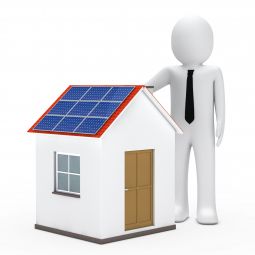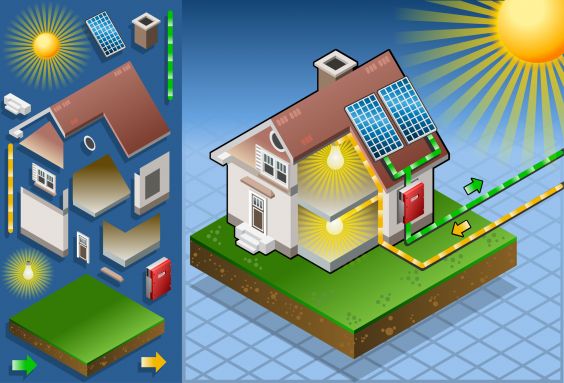How Is Solar Energy Converted Into Electricity New Jersey | How Solar Panels Work
How is solar energy converted into electricity?
Solar energy or sunlight is the most abundant renewable energy on Earth. The sun sends out the most significant part of its energy in the form of photons, which are packets of energy that can be heated, moved, or used to do work when absorbed by any substance. Solar cells are made of semiconductor materials such as silicon or gallium arsenide, also known as PV cells. These cells capture the sun’s energy and use it to move electrons from a negative source to a positive one. In this way, electricity is produced.
Active solar energy
Active solar energy is the process of converting sunlight into energy or thermal energy. This can be done through a variety of means, including photovoltaic cells, concentrated solar power, and solar water heating. Active solar energy is a clean and renewable source of energy and has many benefits over traditional forms of energy generation. The solar panel generate electricity without emitting greenhouse gases like carbon dioxide and methane, which can contribute to climate change. Solar energy is also a reliable resource; unlike wind or hydropower, it can be harnessed even when the weather is not ideal.
Passive solar energy
Passive solar energy is the process of using sunlight to provide natural lighting, heating, ventilation, and cooling in buildings, by means that do not involve moving parts (e.g., solar-thermal collectors or fluid-filled pipes) Manufactured Passive Solar Collectors are designed by following scientific/engineering rules for collecting, trapping and storing the energy.

The initial step in converting energy into electricity is to install photovoltaic (PV) cells or solar cells. These are made of materials that show the photovoltaic effect, meaning when the sun’s rays strike the solar cells, photons of light spook electrons inside the cell, triggering them to start flowing, ultimately producing electricity.
Photovoltaic cells are used for powering calculators, watches, and other electronic devices and supplying electricity to homes and communities. The next step is to interconnect these cells with other components in an electric circuit to provide electricity to external devices. The elements that are usually used include copper wires and metal clamps. The device that is connected and uses the electricity gets charged by sunlight.
Solar energy conversion efficiency depends on how many photons strike a specific surface within a particular time. The best cells have the highest energy conversion rate at which they absorb light and convert solar energy into electrical energy. A more efficient cell has a large surface area relative to its thickness.
Solar cells are classified according to the way they are fabricated and the materials used.
Monocrystalline Silicon Solar Cells
One of the most common types is monocrystalline silicon photovoltaic cells. These cells are made from a single crystal of silicon, and they have an efficiency rate close to 20 percent when exposed to full sunlight. The energy conversion process begins with photons striking the semiconductor cell, treated with boron to add positive charges, or “holes.” The negative charges, or electrons, are then forced to move towards the positive terminals of the cell. Once electricity is generated, it can be passed through a diode and stored in a battery for use at a later time.
These cells are inefficient when used under partially shaded conditions because light only penetrates part of the cell. However, they are ideal for other applications such as arrays connected to batteries or electrical inverters so electricity can be used when needed.

Polycrystalline Silicon Solar Cells
This type of solar cell is made from multiple crystals of silicon photovoltaic cells. They have an efficiency rate of around 13 – 16 percent, and the energy conversion process is similar to that of monocrystalline silicon cells. The wafers of polycrystalline solar panels are made up of several small fragments of silicon.
Thin Film Solar Cells
Another type of solar cell is thin-film solar cells, made from the same semiconductor material used in monocrystalline and polycrystalline silicon cells. Instead of being shaped into an ingot or wafer, these cells are deposited on another material. One example is amorphous silicon that is deposited directly onto a substrate or other material. Amorphous silicon has an efficiency rate of up around 6 to 7 percent, and it is the most common type of thin-film cells.
How do solar panel generate electricity?
There are several steps to this process. Solar panels convert direct current (DC) electricity into an alternating current (AC). The DC is generated from the solar cells and then sent through an inverter circuit, to convert into AC. The AC power can now be used to run devices either directly or with the help of a battery, which is a rechargeable power source.
The next step is to connect the solar panels to a charge controller, a device meant to control the flow of electricity from the solar panels into batteries or load cells that draw current from them. The battery that stores energy from the sun’s rays can run devices at night or on cloudy days.
The last step is to connect the batteries or load cells to devices that will use them for electricity. This can be done through an inverter circuit, depending on whether the device requires AC or DC power. The process of charging the battery with energy starts again when daylight returns.

Panels
A solar panel is a device that comprises arrays of PV cells. These panels form the basic building block for all photovoltaic systems used in homes, businesses, and industries. A solar panel is made up of a silicon photovoltaic cell or thin-film semiconductor materials that absorb photons producing electricity and transparent conductive materials that conduct electricity to the cells.
Charge Controller
A solar charge controller is a device used to manage the batteries that store electricity from the sun’s rays. This ensures that the batteries are not overcharged or undercharged by regulating how much energy they receive from solar panels at any given time. A battery should never be overcharged, as this can cause damage and shorten its lifespan. At night when there is no sunlight, electricity can be drawn from the battery for running appliances.
Battery
A battery stores electricity generated by solar photovoltaic cells. It is similar to the batteries used in cell phones and laptops but larger. Batteries can be connected directly to devices or function as a backup system for solar panels that do not supply enough power. A deep cycle battery stores energy for long periods, and it allows users to draw and store electricity when needed.
Inverter
Devices such as refrigerators, fans, and computers need AC electricity to work. An inverter is a circuit board that converts solar power from DC to AC. The inverter changes the direct current from solar cells into alternating current that is suitable for running appliances. There are different types of inverters with varying levels of efficiency, use, and cost.
Pros and Cons of Solar Energy
Pros:
- Solar energy is a renewable and clean source of energy. It does not produce greenhouse gases, and it has no negative environmental impacts.
- Solar cells do not require fuel or generate hazardous waste, as fossil fuels do. They also do not emit toxic fumes like those produced by burning coal to create electricity.
- Solar energy can help reduce electricity bills, and it is more economical than connecting to the power grid.
- Solar panels work silently, which means they will not interfere with home appliances such as televisions and computers.
- The initial costs of installing solar devices like photovoltaic cells and batteries are offset by savings on electricity bills quickly.
- Solar energy enables businesses to save on their utility bills.
- Solar power can be used in disaster relief and military operations to provide electricity when grid power is unavailable.
Cons:
- A more expensive initial investment for homes and business owners looking to install solar panels means that lower electricity bills must offset the cost of installation.
- Solar devices can be faulty and result in a loss of power or a decrease in the area supplied by solar panels. Repairs and maintenance costs for these devices also add to the overall cost.
- To harness sunlight, it must be outside and therefore cannot always provide adequate power during the night or in cloudy conditions.
- Certain states have no incentives for solar power, which means that there are no rebates available to offset the installation costs of homeowners who want to install these devices. This means that the initial investment is higher for these states.
- Solar power only works in areas with direct sunlight and does not work well in shaded or shady areas.
Environmental impact of solar renewable energy

Solar power systems do not release greenhouse gases, and they are clean, renewable energy sources. The only by-product of solar energy is heating. When sunlight strikes the surface of the Earth, it heats areas where solar panels are present. This means that there is no release of harmful toxins into the atmosphere when using solar devices. The process of converting heat into usable electricity is clean and does not harm the environment.
Solar devices also do not require fuel to generate electrical energy, and they do not produce hazardous waste when in use. The mining of materials such as coal for creating power has a negative environmental impact. Mining can damage habitats, release toxic fumes, and deforestation when clearing the Earth for mining purposes. Solar energy does not have these negative environmental impacts.
Solar panels are silent, and they do not interfere with other appliances in a home or office. These devices require little maintenance, which reduces the waste produced when using traditional power sources like coal power plants to generate electrical energy.
Future of solar power energy
Solar energy is a clean, renewable source of electricity. There is potential that solar panels can be used to provide more efficient and effective sources of power in the future. Research has been done into using solar cells to generate hydrogen fuel from sunlight which can then be used in gas-powered cars or converted into electricity in homes and businesses.
Climate change is an actual occurrence that poses a significant danger to humans and other species on the planet.
Many countries have begun to implement clean, renewable energy sources like solar power. For people to continue using electricity and electricity-powered items, a source of power must be found that is both efficient and cost-effective. Solar energy technologies can provide this solution when used in conjunction with other alternative forms of energy such as wind power.
Solar energy is the most abundant and widely used source of energy.
The utilization of solar energy is a way for countries to reduce fossil fuels and reduce greenhouse gas emissions.
As research continues into using these devices more efficiently, it will be possible in the future that they can provide a cheaper source of power with little environmental impact compared to traditional ways of generating electricity. With worldwide populations increasing every year, countries must implement strategies to reduce greenhouse gases and slow down climate change.
Solar photovoltaic technologies have gone through a significant scale-up.
Solar photovoltaic technology has advanced dramatically over the years. China, Germany, Japan, and the United States are just a few countries with significant solar photovoltaic generation capacity.
It is projected that solar generation will make up almost one-third of global electricity production by 2050.
